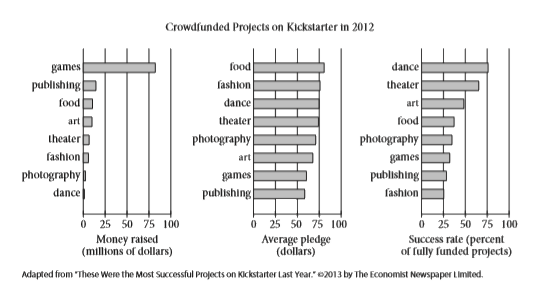Crowdfunding is a popular way to raise money using the Internet The process sounds simple an artist, entrepreneur, or other innovator takes his or her ideas straight to the public via a crowdfunding webs. The innovator creates a video about the project and offers, in exchange for donations, a series of perks," from acknowledgment on a social media site to a small piece of art. Many crowdfunding programs are all-or-nothing, In other words, the innovator must garner 100 percent funding for the project or the money is refunded to the donors. At it's best, the system can give creators direct access to millions of potential backers. The home page of one leading crowdfunding site features a project to manufacture pinhole cameras on a 3-D printer. Ea The idea is obviously very attractive. An obscure method of photography may be made available to many with little expense. Within weeks, the project was 621 percent funded. in contrast, on the same page, a small Brooklyn performance venue is attempting to raise money for its current season. The venue features works of performance art showcased in a storefront window. Those who have seen the space consider it vital. low ever, that group may not be large enough, with iu•t fourteen days to go in the fund raising period, the campaign is only 46 percent funded.
Artists such as these Brooklyn performers find that crowdfunding exacerbates problems that already exist. El Work, that is easily understood and appreciated, is supported, while more complex work goes unnoticed. Time that could be used creating art is spent devising clever perks to draw the attention of potential contributors. 28 In addition, audiences may contain many 'free riders," they did not make contributions.
ironically, the success of crowdfunding may weaken overall funding for the arts if people begin to feel that paying for the art 30 loved by them is someone else's responsibility. til One innovative playwright has woven the deficiencies of the system into her crowdfunding model. 121 Though the price for her tickets was higher than that of tickets for comparable shows, it was still affordable to most theatergoers—and reflected the real cost of the performance. [3] She presented the total cost for producing her play on a crowdfunding site. [4] Then she divided the total cost by the number of people she expected to attend the performance. [5) The result of the calculation was the minimum donor price, and only donors who paid at least the minimum ticket price were allowed to attend the performance. [6) By subverting the presumption that money used for her project is an altruistic donation, the playwright showed that W our work has monetary value to those who enjoy It.

Which choice offers an accurate interpretation of the data in the graph?
The project category with the lowest amount of money raised was also the most successfully funded project category
The project category with the highest average pledge amount was also the most successfully funded project category
The project category with the lowest average pledge amount was also the project category that raised the most money
The project category with the highest average pledge amount was also the project category with the most money raised.
Choice A is the best answer because it accurately interprets data in the graph. The category “dance” had the lowest amount of money raised but also had the highest percentage of projects fully funded.
Choices B, C, and D are incorrect because they do not accurately interpret the information provided in the graph.
Similar Questions
एक स्कूटर का पहले 1 किमी का निश्चित किराया है तथा इसके बाद के प्रत्येक किमी के लिये कुछ कम किराया हैं। यदि एक दिन आलिया 5 किमी के ₹24 तथा किसी अन्य दिन के लिये 8 किमी के ₹35.40 का भुगतान करती है तो पहले क्रिमी तया इसके बाद के प्रत्येक किमी का किराया ज्ञात कीजिए।
View Solutionसमस्याओ में रेखिक समीकरण युग्म बनाइए और उनके हल प्रतिस्थापन विधि द्वारा ज्ञात कीजिए :
एक नगर में टैक्सी के भाड़े में एक नियम भाड़े के अतिरिक्त चली गई दुरी पर भाड़ सम्मिलित किए जाता है। 10 किमी दुरी के लिए भाड़ा 105 है तथा 15 किमी के लिए भाड़ा क्या है ? एक व्यक्ति को 25 किमी यात्रा करने के लिए कितना भाड़ा देना होगा ?
View Solutionसमस्याओ में रेखिक समीकरणों के युग्म बनाइए और उनके हल (यदि उनका अस्तित्व हो ) विलोपन विधि से ज्ञात कीजिए :
किराए पर पुस्तके देने वाले किसी पुस्तकालय का प्रथम तीन दिनों का एक नियम किराया है तथा उसके बाद प्रत्येक अतिरिक्त दिन का अलग किराया है । सरिता ने सात दिनों तक एक पुस्तक रखने के लिए 27 अदा किए जबकि सुसी ने एक पुस्तक पाँच दिनों तक रखने के 21 ऐडा किए । नियत किराया तथा प्रत्येक अतिरिक्त दिन का किराया ज्ञात कीजिए ।
View Solutiona और b के मान ज्ञात कीजिए जिनके लिये निम्नलिखित समीकरण निकाय के अपरिमित रूप से अनके हल है :
2x−(a−4)y=2b+1 और 4x−(a−1)y=5b−1
View Solutionदो पाँसों की एक फेंक में अंकों का योग 8 अथवा 10 आने की प्रायिकता ज्ञात कीजिये।
View Solutionयदि 10 टिकटों पर 1 से 10 तक की (प्रत्येक पर एक) संख्यायें लिखी हुई हैं। कोई संख्या दोहराई नहीं गई है। यदि A एक ऐसी घटना है, जिसमें विषम संख्यायें हों और B एक ऐसी घटना हो, जिसमें 3 से विभाज्य संख्या हों, तो दिखाओ कि P(A∪B)=P(A)+P(B)−P(A∪B)
View Solutionएक यौगिक A तथा B तत्वों से मिलकर बना है । जब A परमाणु कोने पर तथा B परमाणु केंद्र पर हो, तो यह यौगिक घनाकार जालक में क्रिस्टल बनाता है । यौगिक का साधारण सूत्र होगा :
View Solutionएक धातु के तार में एक ऐम्पियर की धारा प्रवाहित हो रही है । बताइए एक सेकण्ड में कितने इलेक्ट्रॉन तार के किसी बिंदु से प्रवाहित होते है ?
View Solution
